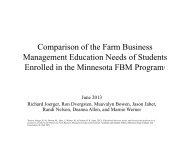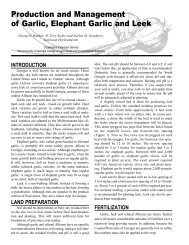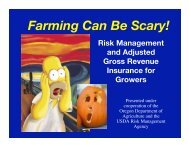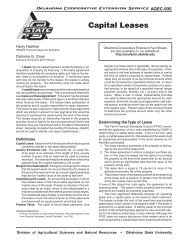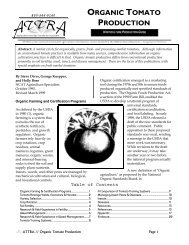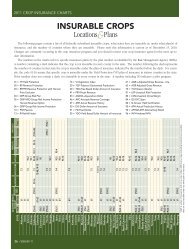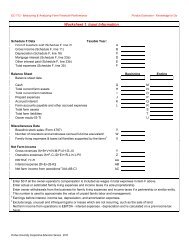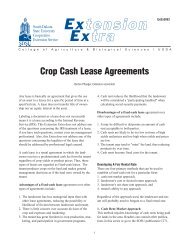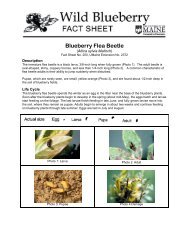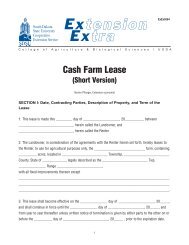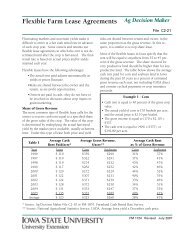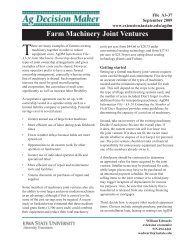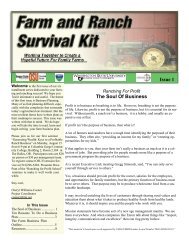Estimating Farm Machinery Costs - National Ag Risk Education Library
Estimating Farm Machinery Costs - National Ag Risk Education Library
Estimating Farm Machinery Costs - National Ag Risk Education Library
Create successful ePaper yourself
Turn your PDF publications into a flip-book with our unique Google optimized e-Paper software.
Used <strong>Machinery</strong><br />
<strong>Costs</strong> for used machinery can be<br />
estimated by using the same procedure<br />
shown for new machinery.<br />
However, the fixed costs usually<br />
will be lower because the original<br />
cost of the machine will be lower.<br />
Repair costs usually will be higher<br />
because of the greater hours of<br />
accumulated use. Therefore, the<br />
secret to successful used machinery<br />
economics is to balance higher hourly<br />
repair costs against lower hourly fixed<br />
costs. If the machine’s condition is<br />
misjudged and the repair costs are<br />
higher than anticipated, or if too high<br />
a price is paid for the machine so<br />
that fixed costs are not as low as<br />
anticipated, the total hourly costs of<br />
a used machine may be as high as or<br />
higher than those of a new machine.<br />
As an example of estimating costs for<br />
a used machine, assume a farmer just<br />
bought a 6-year-old 28-foot tandem<br />
disk for $11,000. It appeared to<br />
be clean and in good mechanical<br />
condition. If the farmer does not<br />
know for sure how many hours<br />
of accumulated use the disk has, it<br />
can be estimated by multiplying its<br />
age (6 years) by the farmer’s own<br />
expected annual use (100 hours per<br />
year), or 600 hours.<br />
What is the estimated total cost of the<br />
disk over the next 8 years? From<br />
Table 1b, the expected salvage value<br />
at the end of 13 years is 24 percent of<br />
the current list price of an equivalent<br />
machine (estimated to be $30,000),<br />
or $7,200.<br />
The capital recovery factor for 8 years<br />
and a 5 percent real interest rate is<br />
.155 (Table 2). Capital recovery<br />
costs are:<br />
Capital recovery = .155 ($11,000 –<br />
$7,200) + ($7,200 .05)<br />
= $589 + $360<br />
= $949/year<br />
For taxes, insurance and housing:<br />
TIH = 0.01 $11,000<br />
= $110/year<br />
Total fixed costs = $949 + $110<br />
= $1,059/year<br />
If the disk is used an average of<br />
100 hours per year:<br />
Ownership cost/hour =<br />
$1,059 100 hours<br />
= $10.59/hour<br />
Use Table 3 to estimate average repair<br />
costs. If the farmer intends to keep<br />
this disk for 8 more years, the<br />
accumulated hours of use after that<br />
time will be:<br />
Accumulated hours = 600 + (100<br />
hours/yr 8 years)<br />
= 1,400 hours<br />
Now, using Table 3, note that the<br />
accumulated repair cost for a tandem<br />
disk after 600 hours is 8 percent of<br />
the new list price. After 1,400 hours it<br />
is estimated at 32 percent. Thus, the<br />
accumulated costs from 600 to 1,400<br />
hours can be estimated at 32 percent<br />
minus 8 percent, or 24 percent of the<br />
new list price. If the list price for a<br />
28-foot tandem disk is $30,000, the<br />
repair costs for the next 8 years are<br />
estimated to be:<br />
Repair costs = .24 $30,000<br />
= $7,200<br />
The repair cost per hour is estimated<br />
to be:<br />
Repair cost per hour = $7,200 <br />
(1,400 – 600) hours<br />
= $7,200 800 hours<br />
= $9.00/hour<br />
Other variable costs, such as fuel,<br />
lubrication, and labor, already have<br />
been included in the variable costs for<br />
the tractor, so the total cost per hour<br />
for the disk is simply the sum of the<br />
ownership costs per hour and the<br />
repair costs per hour:<br />
Total cost = $10.59 + $9.00<br />
= $19.59/hour<br />
When estimating future costs for a<br />
machine that has been owned for<br />
several years, start with the best<br />
estimate of the current market value<br />
of the machine instead of its original<br />
purchase price, or use the salvage<br />
value factor in Table 1a or 1b to<br />
estimate its current value.<br />
Total <strong>Costs</strong> per Operation<br />
Tractor costs must be added to<br />
the implement costs to determine<br />
the combined total cost per hour<br />
of operating the machine. In the<br />
example:<br />
Total cost = $46.56 + 19.59<br />
= $66.15/hour<br />
Finally, total cost per hour can be<br />
divided by the hourly work rate in<br />
acres per hour or tons per hour to<br />
calculate the total cost per acre or<br />
per ton.<br />
The hourly work rate or field capacity<br />
of an implement or self-propelled<br />
machine can be estimated from<br />
the effective width of the machine<br />
(in feet), its speed across the field<br />
(in miles per hour), and its field<br />
efficiency (in percentage). The field<br />
efficiency is a factor that adjusts<br />
for time lost due to turning at<br />
the end of the field, overlapping,<br />
making adjustments to the machine,<br />
and filling or emptying tanks<br />
and hoppers.<br />
7



